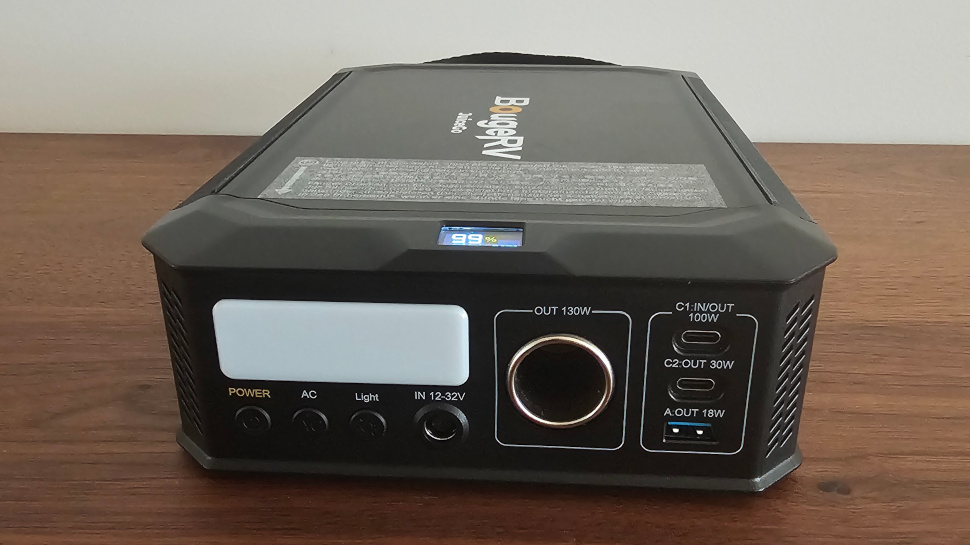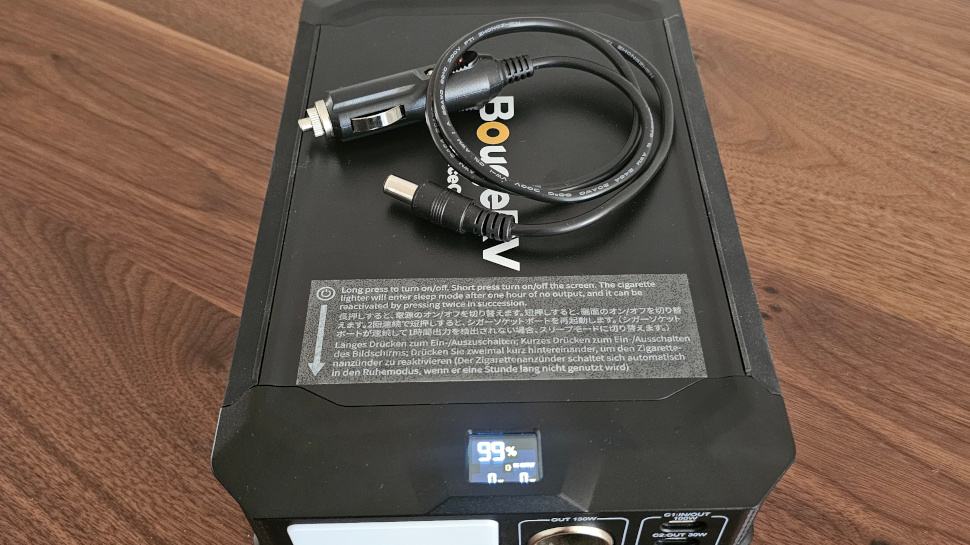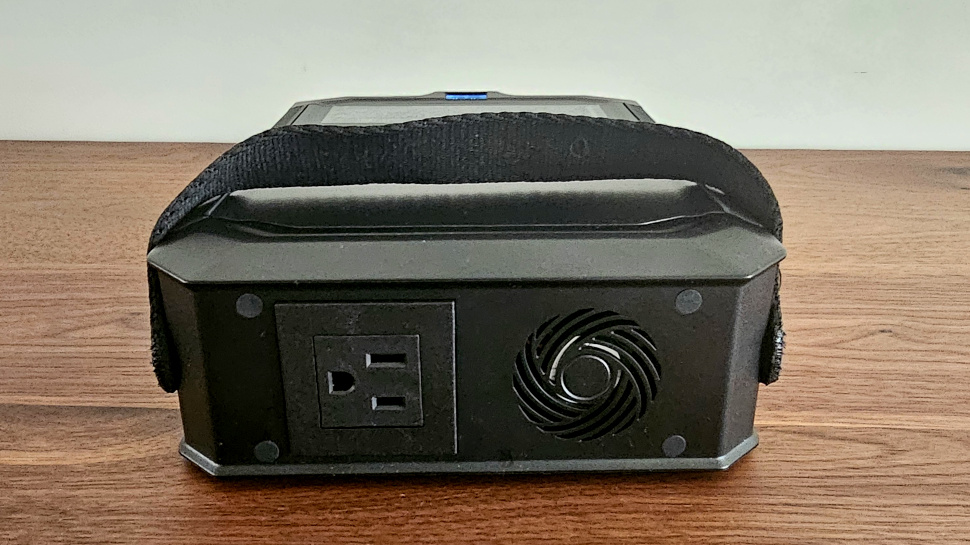BougeRV JuiceGo review
The BourgeRV JuiceGo could be mistaken for a trendy juicer, but make no mistake, this diminutive unit is no pushover and redefines the concept of portable power stations by being slightly larger than a dictionary.
Battery Chemistry: LiFePo4
Battery capacity: 240Wh
Number of charge cycles: Over 2000
AC output power: 150W
Number of AC outlets: 1
Number of DC outlets: 4
AC inverter efficiency: 88%
Number of power inputs: 2
Fastest charge time: 3 hours
Additional features: LED flashlight
Weight: 2.8kg
Volume: 2.7L
Price: $210
The slick plastic enclosure contains a 240WH LiFePo4 battery, three USB sockets, a cigar port, an emergency LED light, and a 150W AC output socket. A small LCD shows input and output power consumption and battery charge.
The JuiceGo is ideal for traveling as it weighs only 2.8kg. The only accessories provided are USB Type-C and car charging cables. A built-in hand strap makes moving the station painless. The main limitation of the unit remains the 100W USB Type-C socket, which cannot be used as output while charging through the DC input socket. The station does not ship with a power adapter, making the out-of-the-box experience underwhelming.
The JuiceGo has an MSRP of $209 on the BourgeRV website. It can be bundled with a 50W solar panel, bringing the price to $300. Until the end of the year, buyers can use the code AFF24 to get 24% off BougeRV products, including the JuiceGo.

BougeRV JuiceGo: Design
The JuiceGo comes with only a few accessories, including a USB Type-C and a car charging cable. To charge the station, the user must provide a power adapter. The plastic unit measures 26 cm x 17 cm x 6 cm and weighs 2.9 kg. A plastic strap serves as a handle for carrying the station around. The back of the enclosure contains a small fan, which cools the AC inverter and battery charging circuits.
The black plastic station does not have any feet, which gives the JuiceGo the unique characteristic of being able to be placed horizontally or vertically. The edge of the case is rubbery and will prevent the station from easily toppling over. BougeRV uses a 240Wh LiFePo4 battery technology with over 3000 charge cycles before experiencing a 20% capacity drop.
The user interface comprises a small rectangular LCD and three push buttons. The display looks crowded from a distance; tiny characters show the battery charge, input and output power consumption, potential warnings, and enabled outputs. Using the push buttons is straightforward. A long press on the Power button will turn the device on, while a short press will turn it off.
The front panel contains all DC outputs. Three USB sockets, including two Type-Cs, are grouped on the right. A cigar car socket in the center provides 130W to small devices such as a portable fridge, while a barrel-type DC7909 socket can charge the unit with a voltage range between 12V and 32V, at a maximum of 100W. A single AC output on the back provides up to 150W.

BougeRV JuiceGo: In use
The JuiceGo fan makes noise under stress when fast charging or outputting at maximum power. The LED flashlight, controlled by the Light push button, can be fully on, dimmed to half intensity, or set to flash. With the 12V cigar lighter DC output, the JuiceGo becomes a helpful roadside companion, enabling the use of a small fridge on the go.
The unit charges through the dedicated DC input socket or the 100W Type-C connector. One major limitation of the power station is that both sockets cannot be used simultaneously, even when using the Type-C as an output. With both connected, the JuiceGo will turn off the Type-C while other outputs, such as the two USB sockets, remain powered.
The fastest way to charge the unit is through the DC7909 socket, which takes about three hours to complete. Since the unit does not ship with an adapter, the user will usually charge through the Type-C connector, which will also take about three hours to complete. The DC7909 socket also supports solar panel charging with MPPT and a 12V to 32V input.
The inverter and battery are 88% efficient, giving less than one and a half hours at full power usage. The unit consumes about 1W while idle and can save energy by turning off the AC outlet or the whole unit with nothing connected for one hour or more. The JuiceGo can become a simple UPS for small computers and appliances, with AC and DC outputs available during charge.

BougeRV JuiceGo: The competition
BougeRV’s JuiceGo fills a niche at this size and price. The Jackery Explorer 300 portable power station is targeted at a similar audience but is more costly at $419. It is also bigger and heavier and uses the older LPF battery chemistry. The lack of a flashlight makes it less handy on road trips. Finally, with only one 60W Type-C USB socket, the Explorer 300 is a no-go for charging many high-end laptops, such as the MacBook Pro, using USB only.
BougeRV JuiceGo: Final verdict
The JuiceGo from BougeRV is ideal as a temporary energy source on the go. The 240Wh LiFePo4 battery should provide over 2000 charge cycles before experiencing a voltage drop. What’s great about the JuiceGo is its many features, such as a flashlight, dual Type-C USB sockets, a cigar lighter output, and a handle that does not take up a lot of space. The unit can be placed horizontally or vertically and features a rubbery edge to prevent accidental slips.
The AC output is on the low end at 150W, meaning the station can only accommodate items such as laptops or small fridges. The charging could also have been better, as the main Type-C socket gets disabled when charging through the dedicated DC input socket.
Buy it
if you need a compact power station for roadside emergencies.
Don’t buy
if you need to charge anything other than small devices.
0 comments:
Post a Comment